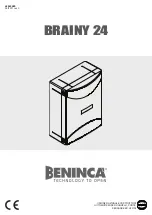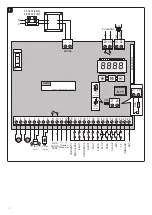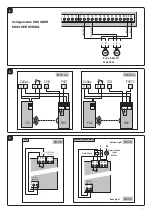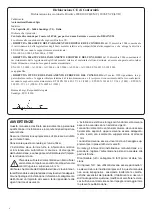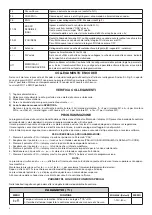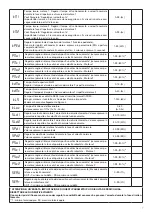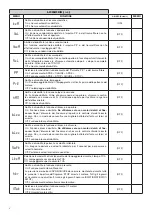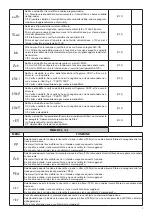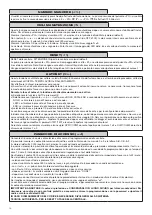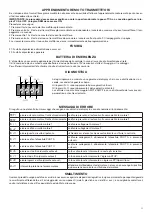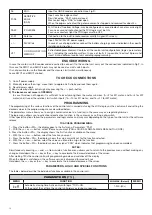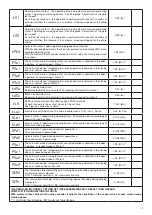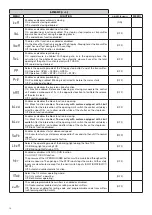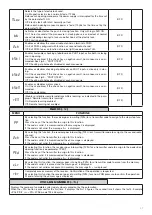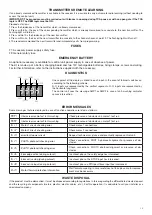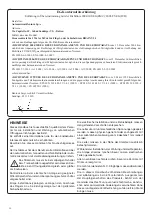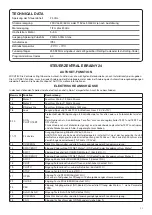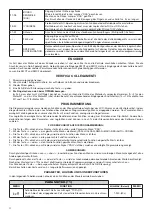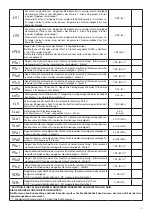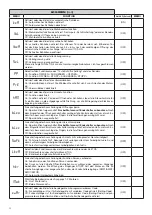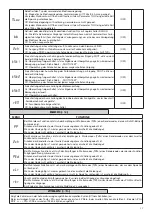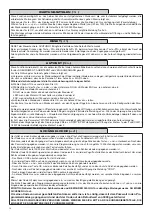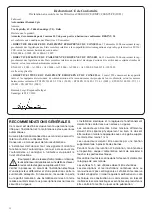
14
26
ENC-
Input for GND Encoder connection (see Fig.2).
27-28
SENSITIVE
EDGE
(DAS)
Input, sensitive edge contact
Resistive edge: “DAS” Jumper closed
Mechanical edge: “DAS” Jumper open
When the edge is activated, the gate movement is stopped and reversed for about 3s.
29-30
II°CH/SERL
N.O. Contact free from Voltage, may be configured as second radio channel or service light.
For use as second radio channel the 2CH logic must be ON.
For use as courtesy light the 2CH logic must be OFF.
31-32
Antenna
Connection to the built-in radio receiver card (30-signal/31-screen).
+ / -
24VAC/dc
Input, 24VAC/24VDC power supply.
In case of use of plug batteries connect the battery charging card as indicated in the specific
installation instructions.
U11
CONFIGURATION
MEMORY
Extractable Eprom Memory. Contains all the control unit configurations (logics, parameters,
etc.), including the radiotransmitters. In case of faults it is possible to extract Eprom and
insert it into a different control unit, avoiding reprogramming.
ENCODER WIRING
In case the motor is with Encoder and one wished to connect it to the control unit, carry out the connections indicated in Fig.2, in
this case the SWO1 and SWO2 inputs may not be used as Limit switch inputs.
It is not possible to use the Encoder and the closure Limit switch simultaneously.
Leave SWC1 and SWC2 shorted.
TO ChECK CONNECTIONS
1) Cut-off power supply.
2) Manually release the wings, move them to approx. half-stroke and lock them again.
3) Reset power supply.
4) Send a step-by-step control signal by pressing the <-> push-button.
5) The leeaves must move in OPENING.
In case this does not happen, it is sufficient to invert among them the motor run wires. (1<>2 for M1 motor, and 3<>4 for M2
motor) and, if used, the relative Limit switch inputs (14<>15 for M1 motor, and 16<>17 for M2 motor).
PROGRAMMING
The programming of the various functions of the control unit is carried out using the LCD display on the control unit and setting the
desired values in the programming menus described below.
The parameters menu allows you to assign a numerical value to a function, in the same way as a regulating trimmer.
The logic menu allows you to activate or deactivate a function, in the same way as setting a dip-switch.
Other special functions follow the parameters and logic menus and may vary depending on the type of control unit or the software
release.
TO ACCESS PROGRAMMING:
1 – Press the button <PG>, the display goes to the first menu, Parameters “PAR”.
2 – With the <+> or <-> button, select the menu you want (PAR>LOG>RAD>NMAN>MACI>RES>AUTO>CODE).
3- Press the button <PG>, the display shows the first function available on the menu.
4 - With the <+> or <-> button, select the function you want.
5 - Press the button <PG>, the display shows the value currently set for the function selected.
6 - With the <+> or <-> button, select the value you intend to assign to the function.
7 - Press the button <PG>, the display shows the signal “PRG” which indicates that programming has been completed.
NOTES:
Simultaneously pressing <+> and <-> from inside a function menu allows you to return to the previous menu without making any
changes. Hold down the <+> key or the <-> key to accelerate the increase/decrease of the values.
After waiting 120s the control unit quits programming mode and switches off the display.
When the board is switched on, the software version is displayed for around 5 sec
Hold down the <+> key or the <-> key to accelerate the increase/decrease of the values.
PARAMETERS, LOGIC AND SPECIAL FUNCTIONS
The tables below describe the individual functions available in the control unit.
PARAMETERS (
PAR
)
MENU
FUNCTION
MIN-MAX-(Default)
MEMO
TCA
Automatic closing time. Active only with logic “TCA”=ON.
At the end of the set time the control unit orders a closing manoeuvre.
1-240-(40s)

